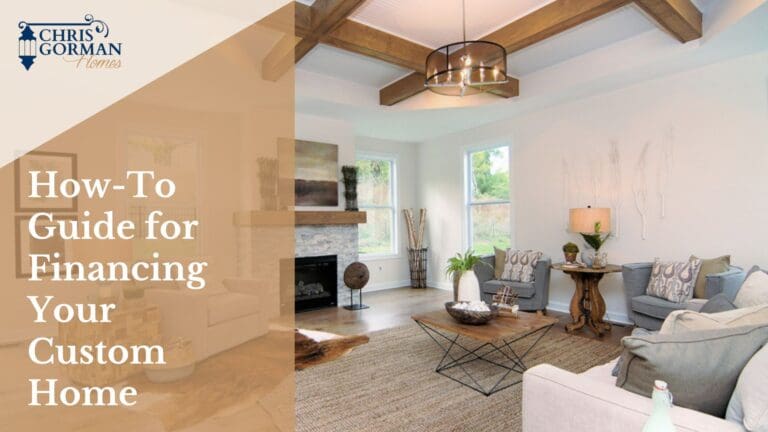How-To Guide for Financing Your Custom Home

Financing a custom-built home differs from the process of financing an existing home. Instead of a traditional mortgage, you’ll need a custom home loan that covers construction costs and transitions into a permanent mortgage upon completion. Knowing the financial steps to building a house can help you navigate the process smoothly and avoid common pitfalls.
Step 1: Establish Your Budget
The first step in financing a house is determining how much you can afford. Developing a solid budget includes factoring in:
- Land acquisition costs.
- Construction expenses.
- Permits and fees.
- Interior and exterior finishes.
Meeting with a financial advisor or mortgage lender early can help set realistic expectations for your custom home construction loan.
Step 2: Explore Loan Options for Custom Homes
There are several types of custom home loans available, each with unique benefits:
Construction-to-Permanent Loan
This is the most common home builder financing option. It covers the building phase and then converts into a traditional mortgage upon completion. Payments are interest-only during construction.
Stand-Alone Construction Loan
This loan only finances the building phase. Once construction is complete, you must secure a separate mortgage, which may require another round of approval.
Owner-Builder Loan
If you plan to act as your own general contractor, you may qualify for an owner-builder loan. These loans often require strong financial standing and extensive experience in construction.
VA or FHA Construction Loans
If you’re eligible for a VA or FHA loan, you may qualify for special financing for building a home with lower down payments and favorable terms.
Step 3: Secure Pre-Approval
Before selecting a builder or purchasing land, obtain pre-approval for your custom home loan. Lenders will evaluate your:
- Credit score.
- Debt-to-income ratio.
- Employment history.
- Down payment amount.
A strong financial profile improves your chances of securing favorable loan terms and a smoother approval process.
Step 4: Find the Right Lender
Not all lenders specialize in financing a custom-built home. Look for lenders experienced in custom home financing who can guide you through the financial process of building a house. Some common questions you can ask lenders include:
- Can I get a mortgage to build a house?
- How does building a house work financially?
- How do you finance building a house?
Step 5: Understand the Disbursement Process
Unlike a traditional mortgage, custom home loans distribute funds in stages called “draws.” These disbursements occur at key milestones, such as:
- Land purchase.
- Foundation completion.
- Framing.
- Interior and exterior finishing.
- Final inspection.
Your builder and lender will work together to ensure payments align with project progress. Disbursements are usually based on pre-agreed construction milestones.
Step 6: Plan for Contingencies
Unexpected costs are common when financing building a home. Setting aside 10 to 20 percent of your budget for contingencies can help you manage unexpected expenses without delaying construction.
Step 7: Transition to a Permanent Mortgage
Once construction is complete, your custom home construction loan will convert into a long-term mortgage. This process involves:
- A final inspection and appraisal.
- Closing on your new mortgage.
- Establishing regular mortgage payments.
FAQs About Custom Home Financing
Can you get a loan to build your own house?
Yes, but lenders often require a strong credit score and detailed building plans.
How do you get a loan to build your own house?
Start by securing a lender experienced in custom home financing, get pre-approved and work with a reputable builder.
Can you finance building a house?
Yes, through specialized custom home loans like construction-to-permanent or stand-alone loans.
Additional Considerations for Financing Your Custom Home
Understanding Interest Rates
Interest rates for construction loans may be higher than traditional mortgages. It’s essential to understand whether your rate is fixed or variable during construction.
Down Payment Requirements
Down payment requirements vary depending on the loan type. Construction loans typically require at least 20 percent, though VA and FHA loans may have lower requirements.
Timeline Expectations
Building a custom home can take six to 12 months or more. Understanding your lender’s loan terms and extension options can help you stay on track financially.
Builder Selection
Choosing an experienced builder like Chris Gorman Homes can streamline financing. Lenders may require a builder’s license, proof of insurance and past project history before approving financing.
Insurance and Risk Management
Construction loans often require builder’s risk insurance to protect against unexpected damages or delays. Work with your lender and builder to ensure proper coverage.
Tax Implications
Property taxes may increase once construction is complete. Understanding tax implications and potential deductions for home construction can help with long-term planning.
Choosing Between Fixed and Adjustable-Rate Mortgages
Once your construction loan transitions to a permanent mortgage, you will need to decide between a fixed-rate or adjustable-rate mortgage (ARM). Fixed-rate mortgages offer consistent payments, while ARMs may start with lower rates that adjust over time.
Evaluating Closing Costs
Closing costs for custom home loans can be higher than traditional mortgages due to additional appraisals, inspections and lender fees. Understanding these costs upfront can help with budgeting.
Managing Loan Draws Efficiently
Working closely with your builder and lender ensures that draw requests are submitted and approved promptly, preventing unnecessary construction delays.
Preparing for Post-Construction Expenses
Once your home is built, additional expenses such as landscaping, furnishing and maintenance costs should be factored into your financial planning.
The Role of Credit in Custom Home Financing
Your credit score plays a crucial role in determining your eligibility for a construction loan and the interest rate you receive. A higher credit score can result in lower interest rates, reducing overall loan costs. If your credit score needs improvement, consider paying down debts and making timely payments before applying for financing.
Understanding Loan-to-Value Ratio (LTV)
The loan-to-value (LTV) ratio compares the loan amount to the appraised value of the home. Lenders typically prefer an LTV of 80 percent or lower, meaning you may need to provide a 20 percent down payment to meet requirements.
The Importance of a Detailed Construction Plan
Lenders require a well-documented construction plan before approving a loan. This includes architectural drawings, a project timeline, a budget breakdown and a contract with an approved builder. Ensuring these documents are in order can expedite the approval process.
Alternative Financing Options
For those who do not qualify for traditional construction loans, alternative financing options include:
- Personal loans: Though not ideal for large amounts, personal loans can help cover smaller expenses.
- Home equity loans: If you own property with equity, a home equity loan can provide funding for construction.
- Private lenders: Some borrowers opt for private lenders or real estate investment firms for financing.
Protecting Your Investment
Throughout the construction process, it’s important to maintain proper documentation, including receipts, contracts and correspondence with your builder and lender. Keeping detailed records ensures transparency and can help resolve any disputes that arise.
Final Thoughts: Start Building Your Dream Home
Financing a custom-built home requires careful planning, research and the right loan. By understanding how to finance building your own home, you can confidently embark on your home-building journey. Contact us to explore custom home financing options with Chris Gorman Homes and begin designing the home of your dreams.
-
Chris Gorman
Chris grew up in a family landscape contracting business, gaining early exposure to construction. After earning a degree in landscape architecture from The Ohio State University, he transitioned from commercial landscape construction to home building, founding Chris Gorman Homes on the principles he learned along the way.

